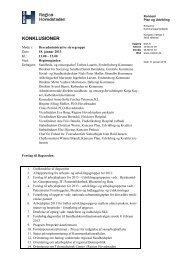Territorial Review Copenhagen - Region Hovedstaden
Territorial Review Copenhagen - Region Hovedstaden
Territorial Review Copenhagen - Region Hovedstaden
Create successful ePaper yourself
Turn your PDF publications into a flip-book with our unique Google optimized e-Paper software.
214<br />
Ministry of Environment. Although the structural reform was presented as a<br />
reform to create local units big enough for larger tasks, the City of<br />
<strong>Copenhagen</strong> has in fact lost several of its previous responsibilities. In<br />
addition, it became a municipality on a par with the other 97 municipalities,<br />
without any special rights or responsibilities. This clearly differs from<br />
practices in several OECD countries with dominant cities (Box 3.1).<br />
Municipalities in the Capital <strong>Region</strong> (other than <strong>Copenhagen</strong> and<br />
Frederiksberg) were granted more responsibilities, but they amalgamated to<br />
a more limited extent than in Jutland. This calls into question whether their<br />
local capacity is sufficient: in 2006, none of the municipalities in the Capital<br />
<strong>Region</strong> was among the ten smallest; today, after the structural reform, half<br />
of the ten smallest municipalities are located in the Capital <strong>Region</strong>.<br />
Box 3.1. Special institutional arrangements for metropolitan areas<br />
Several cities in federal countries are also federal states of their own. This is<br />
for example the case for Berlin, Bremen, Hamburg, Vienna and Brussels. In<br />
other countries, the capital city has a special status, with an institutional<br />
organisation different from other municipalities‘, for example in the Czech<br />
Republic, France, Hungary, Poland, Slovakia and the United Kingdom. Capitals<br />
or metropolitan areas may also have a different status, giving them more<br />
financial resources and rights or responsibilities. This is for example the case for<br />
Tokyo and 17 designated cities that generally have more than 500 000 residents;<br />
Seoul and six other metropolitan areas in Korea; 16 metropolitan municipalities<br />
in Turkey; cities in the Netherlands with more than 100 000 inhabitants; and the<br />
city of Toronto.<br />
3.2 Intergovernmental co-ordination<br />
3.2.1 Metropolitan co-ordination<br />
The national government took many initiatives recognising how<br />
important it was for <strong>Copenhagen</strong> to compete with other European countries<br />
during the 1990s. The key elements of this strategy were recommended by<br />
an Initiative Group for the Capital <strong>Region</strong>, formed in 1989 as a reaction to<br />
economic decline in <strong>Copenhagen</strong> in the 1970s and 1980s. This group,<br />
composed of regional stakeholders, recommended a number of<br />
infrastructural projects, including the Øresund Bridge between <strong>Copenhagen</strong><br />
and Malmö, the development of Ørestad, the expansion of <strong>Copenhagen</strong>

















